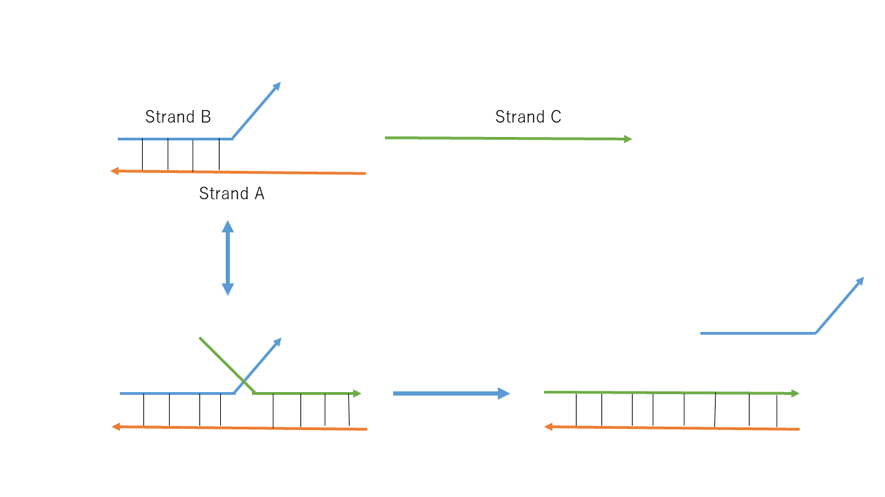Project
Background
DNA origami
DNA origami is a DNA folding structure that creates non-arbitrary two-dimensional or three-dimensional mechanisms at the nanoscale. With the specificity of the interaction between complementary base pairs, DNA becomes a useful material through the design of its base sequence. In the process, we use a long single-stranded DNA called scaffold chain and a large number of short single-stranded DNA called staple chains as scaffolds for the formation of structures. Staple strands usually have a length of 32 bases and fix the desired planar structure like a staple. We do this in various places, resulting in a pre-designed 2D or 3D shape. By binding fluorescent materials (fluorescent molecules, etc.) to DNA, the designed DNA origami can be directly observed using an electron microscope, an atomic force microscope, or the like.
DNA strand displacement reaction
DNA strands bind to more complementary and stable strands. Utilizing this property, a reaction occurs in which one strand of double-stranded DNA exchanged with another single strand. This reaction is known as strand displacement reaction. By using this reaction, operations and logic gates can be constructed, and various functions can be imparted at the nanoscale. However, if this reaction is used, an undesired form of reaction may occur, which leads to the disadvantage of being difficult to use. This disadvantage can be eliminated by using mismatched base pairs, and the correct reaction can be achieved.

Figure1: model of DNAstrand displacement reaction
Mismatched base pair
Usually, DNA is complemented with cytosine (C) and guanine (G), adenine (A) and thymine (T), and these form a double-stranded form by binding. Conversely, C and A combine weakly. This weakly combination is called mismatched base pair. By using mismatched base pairs, we reduce greatly the possibility of an unexpected reaction, and the intended reaction can be easily obtained. However, since a portion that is difficult to bond to the double-stranded appears, the force at the time of bonding becomes weaker than the original, and the strength remains uneasy.
The Problem
The two-dimensional mechanism expressed by DNA origami has been used as a design and expressionfor a device. For example, a smiley face or a map. However, many of the DNA origami functions have a three-dimensional structure. For example, the role of Box by creating a hollow three-dimensional structure, or the structure of a birdcage by creating planar structures with pleated. Structures with functions are also made. On the other hand, few DNA origami composed in two dimensions have biochemical and useful functions. Therefore, We were wondering if it could be used more industrially with 2D DNA origami.
TWe came across with one of the competitions that we found called “NanoCar race” There are nanoscale car racing events in France. In this event, I run 4 groups at the same time, but there seems to be no signal that means start. If there is a nano-sized car, we thought that it would be better to exist a nano-sized signal. And this time we would like to propose creating a nano-sized signal.
Our Idea
Idea
It would be desirable if the location can be fixed and turned on and off when producing nano-sized signals. This is the idea we thought of.
"Strand Displacement reaction on DNA origami"
To give a function to the DNA origami of the two-dimensional mechanism, this time we considered combining with a strand displacement reaction. Based on DNA origami as our idea, we will build a mechanism that allows two substances, a fluorescent substance and a quenching substance to react. Specifically, the fluorescent substance is designed to be fixed to DNA origami. DNA origami is a planar structure, but it makes a single strand appear from the structure. Then, a quencher that binds to a DNA strand complementary to the single strand is prepared. Design a mechanism that allows the two substances to react after the two have been combined to complete the double strand (strand displacement reaction). Experiments based on this idea were carried out step by step using quenchers and fluorescent materials. First, an experiment to perform a strand displacement reaction using a fluorescent substance and a quenching substance and an experiment to create a DNA origami with a single suspended strand are performed separately. And we confirmed whether it would be as designed by combining these.
Merit
In the case of the string shape, the desired reaction cannot be obtained at an appropriate timing, but the presence of the planar structure allows the reaction to be performed reliably and the timing can be measured. Also, since the base is origami, in the case of resin (synthesized using chemical substances), there is no difference in the structural formula, and strands are arranged at random, and it is difficult to design the position to be fixed. On the other hand, DNA has a sequence based on four bases, and the position can be designated based on the sequence, which has an advantage. In addition, if DNA origami can be created on a base such as a plate using a raw material such as glass or silicon, it is possible to wash away the unnecessary single strand after the reaction. This allows the recycling of the strand displacement reaction.